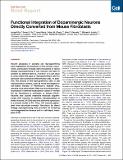| dc.contributor.author | Kim, Jongpil | |
| dc.contributor.author | Su, Susan C. | |
| dc.contributor.author | Wang, Haoyi | |
| dc.contributor.author | Cheng, Albert W. | |
| dc.contributor.author | Cassady, John P. | |
| dc.contributor.author | Lodato, Michael Anthony | |
| dc.contributor.author | Lengner, Christopher J. | |
| dc.contributor.author | Chung, Chee Yeun | |
| dc.contributor.author | Dawlaty, Meelad M. | |
| dc.contributor.author | Tsai, Li-Huei | |
| dc.contributor.author | Jaenisch, Rudolf | |
| dc.date.accessioned | 2014-12-16T21:36:17Z | |
| dc.date.available | 2014-12-16T21:36:17Z | |
| dc.date.issued | 2011-10 | |
| dc.date.submitted | 2011-09 | |
| dc.identifier.issn | 19345909 | |
| dc.identifier.uri | http://hdl.handle.net/1721.1/92351 | |
| dc.description.abstract | Recent advances in somatic cell reprogramming have highlighted the plasticity of the somatic epigenome, particularly through demonstrations of direct lineage reprogramming of one somatic cell type to another by defined factors. However, it is not clear to what extent this type of reprogramming is able to generate fully functional differentiated cells. In addition, the activity of the reprogrammed cells in cell transplantation assays, such as those envisaged for cell-based therapy of Parkinson's disease (PD), remains to be determined. Here we show that ectopic expression of defined transcription factors in mouse tail tip fibroblasts is sufficient to induce Pitx3+ neurons that closely resemble midbrain dopaminergic (DA) neurons. In addition, transplantation of these induced DA (iDA) neurons alleviates symptoms in a mouse model of PD. Thus, iDA neurons generated from abundant somatic fibroblasts by direct lineage reprogramming hold promise for modeling neurodegenerative disease and for cell-based therapies of PD. | en_US |
| dc.description.sponsorship | National Institutes of Health (U.S.) (Grant NIH R37 HD045022 (6-9)) | en_US |
| dc.description.sponsorship | Howard Hughes Medical Institute | en_US |
| dc.language.iso | en_US | |
| dc.publisher | Elsevier | en_US |
| dc.relation.isversionof | http://dx.doi.org/10.1016/j.stem.2011.09.011 | en_US |
| dc.rights | Article is made available in accordance with the publisher's policy and may be subject to US copyright law. Please refer to the publisher's site for terms of use. | en_US |
| dc.source | Elsevier | en_US |
| dc.title | Functional Integration of Dopaminergic Neurons Directly Converted from Mouse Fibroblasts | en_US |
| dc.type | Article | en_US |
| dc.identifier.citation | Kim, Jongpil, Susan C. Su, Haoyi Wang, Albert W. Cheng, John P. Cassady, Michael A. Lodato, Christopher J. Lengner, et al. “Functional Integration of Dopaminergic Neurons Directly Converted from Mouse Fibroblasts.” Cell Stem Cell 9, no. 5 (November 2011): 413–419. © 2011 Elsevier Inc. | en_US |
| dc.contributor.department | Massachusetts Institute of Technology. Department of Biology | en_US |
| dc.contributor.department | Massachusetts Institute of Technology. Department of Brain and Cognitive Sciences | en_US |
| dc.contributor.department | Picower Institute for Learning and Memory | en_US |
| dc.contributor.department | Whitehead Institute for Biomedical Research | en_US |
| dc.contributor.mitauthor | Tsai, Li-Huei | en_US |
| dc.contributor.mitauthor | Jaenisch, Rudolf | en_US |
| dc.contributor.mitauthor | Su, Susan C. | en_US |
| dc.contributor.mitauthor | Cheng, Albert W. | en_US |
| dc.contributor.mitauthor | Cassady, John P. | en_US |
| dc.contributor.mitauthor | Lodato, Michael Anthony | en_US |
| dc.relation.journal | Cell Stem Cell | en_US |
| dc.eprint.version | Final published version | en_US |
| dc.type.uri | http://purl.org/eprint/type/JournalArticle | en_US |
| eprint.status | http://purl.org/eprint/status/PeerReviewed | en_US |
| dspace.orderedauthors | Kim, Jongpil; Su, Susan C.; Wang, Haoyi; Cheng, Albert W.; Cassady, John P.; Lodato, Michael A.; Lengner, Christopher J.; Chung, Chee-Yeun; Dawlaty, Meelad M.; Tsai, Li-Huei; Jaenisch, Rudolf | en_US |
| dc.identifier.orcid | https://orcid.org/0000-0003-1262-0592 | |
| dspace.mitauthor.error | true | |
| mit.license | PUBLISHER_POLICY | en_US |
| mit.metadata.status | Complete | |
